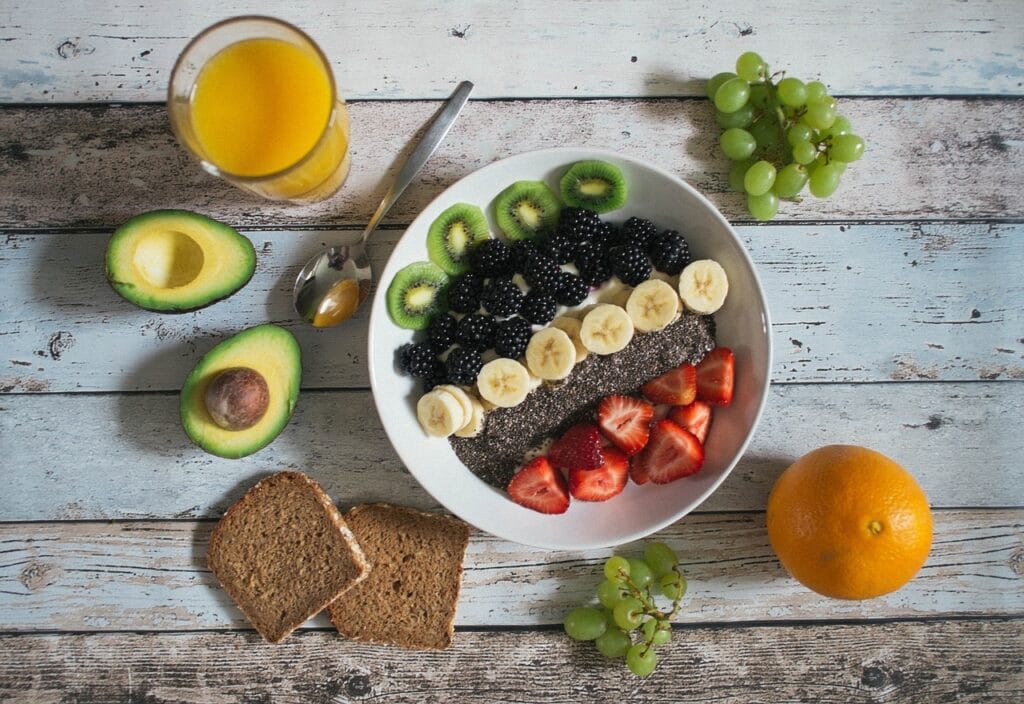Providing children with nutritious healthy food is crucial for their growth, development, and overall well-being. As parents and caregivers, it’s our responsibility to instill healthy eating habits from an early age. Let’s explore some smart food choices that can help kids thrive.
Table of Contents
Colorful Fruits and Vegetables

Encourage kids to “eat the rainbow” by offering a variety of colorful fruits and vegetables1. These nutrient-packed foods provide essential vitamins, minerals, and fiber. Try serving:
- Berries for antioxidants
- Leafy greens for iron and calcium
- Orange fruits and vegetables for vitamin A
Make fruits and veggies fun by cutting them into interesting shapes or creating colorful fruit kebabs for your kids to eat healthy food.
Whole Grains for Sustained Energy
Replace refined grains with whole grain options to provide lasting energy and important nutrients2. Good choices include:
- Whole wheat bread and pasta
- Brown rice
- Quinoa
- Oatmeal
These healthy foods offer more fiber, vitamins, and minerals than their refined counterparts.
Lean Proteins for Growth
Protein is essential for building and repairing tissues. Opt for lean protein sources such as:
- Chicken and turkey
- Fish
- Eggs
- Beans and lentils
- Nuts and seeds (for older children)
These foods support muscle development and help kids feel fuller for longer1.
Healthy Fats for Brain Development
Don’t shy away from healthy fats, which are crucial for brain development. Include foods like:
- Avocados
- Olive oil
- Fatty fish (salmon, mackerel)
- Nuts and seeds
These provide essential omega-3 fatty acids and other beneficial nutrients8.
Limit Processed Foods and Added Sugars
Reduce the intake of processed foods, sugary snacks, and sweetened beverages1. Instead, offer whole foods and natural treats like:
- Fresh fruit for dessert
- Homemade smoothies
- Yogurt with berries
Make Mealtimes Fun and Engaging
Involve kids in meal planning and preparation to spark their interest in healthy eating1. Try:
- Letting them choose fruits and vegetables at the grocery store
- Having them help with simple cooking tasks
- Creating fun names for healthy dishes
Stay Hydrated with Water
Encourage water as the primary beverage choice. Limit sugary drinks and opt for:
- Infused water with fruit slices
- Unsweetened herbal teas (for older children)
- Milk or fortified plant-based alternatives
Tips
Remember, children often mimic adult behaviors. Make healthy food eating a family affair by:
- Eating meals together
- Choosing nutritious foods yourself
- Talking positively about healthy eating
By incorporating these healthy food choices into your child’s diet, you’re setting them up for a lifetime of good nutrition and well-being. Remember to consult with a pediatrician or registered dietitian for personalized advice, especially if your child has specific dietary needs or restrictions.
FAQ: Healthy Food Choices for Children
1. What are the best fruits and vegetables for kids?
Answer:
The best fruits and vegetables for kids are colorful and nutrient-rich options like berries (high in antioxidants), leafy greens (rich in iron and calcium), and orange produce like carrots and mangoes (packed with vitamin A). Encouraging kids to “eat the rainbow” supports overall health and development.
2. Why are whole grains important for children’s growth?
Answer:
Whole grains such as brown rice, quinoa, oatmeal, and whole wheat bread provide sustained energy and are rich in fiber, vitamins, and minerals. They support digestion, stabilize energy levels, and help kids stay full longer.
3. What are some healthy protein options for children?
Answer:
Lean protein sources like chicken, turkey, fish, eggs, beans, lentils, and nuts (for older children) are essential for growth and repair of tissues. Protein supports muscle development and strengthens the immune system.
4. How do healthy fats benefit a child’s development?
Answer:
Healthy fats, including those from avocados, olive oil, fatty fish, and nuts, are crucial for brain development, hormone production, and absorption of certain vitamins. Omega-3 fatty acids in particular enhance cognitive function and memory.
5. How can I reduce my child’s intake of processed foods and sugar?
Answer:
You can reduce processed foods by offering whole food alternatives like fresh fruit, yogurt with berries, or homemade smoothies. Encourage water over sugary drinks and read food labels to avoid hidden sugars and additives.
6. What are fun ways to encourage kids to eat healthy food?
Answer:
Involve children in meal planning, let them pick fruits and vegetables during grocery shopping, and engage them in simple cooking tasks. You can also create fun names for dishes and present food in colorful, creative ways to boost interest.
7. How much water should children drink each day?
Answer:
Water needs vary by age, but generally, children should drink about 5 to 8 cups of water daily. Offer water regularly and use fun methods like fruit-infused water to make hydration more appealing.
8. How can I model healthy food eating habits for my kids?
Answer:
Modeling healthy behavior includes eating nutritious meals yourself, having meals together as a family, and maintaining a positive attitude toward healthy food. Kids learn by example, so your habits matter.
